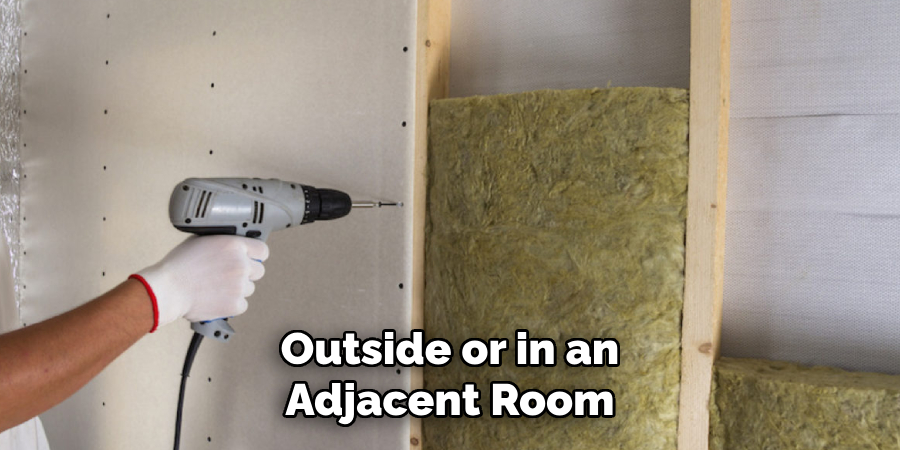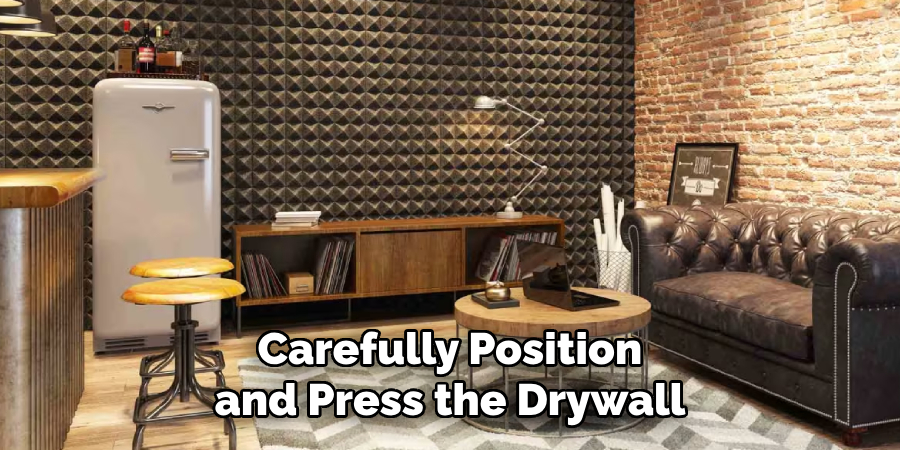Are you tired of hearing the noise from outside your home or apartment? Or you live in a loud neighborhood and want to create a peaceful oasis inside your walls. Whatever the reason may be, how to soundproof walls can significantly improve the quality of life in your living space.
In today’s fast-paced world, finding peace and quiet in our homes can be challenging. Whether it’s the noise from traffic, neighbors, or even other rooms in the house, unwanted sounds can disrupt our daily lives. Soundproofing walls effectively solves this problem, creating a serene and private environment. Soundproofing can enhance comfort and productivity and improve the overall living experience by reducing noise transmission from one space to another.

This guide will explore various techniques and materials for effectively soundproofing your walls and ensuring tranquility in your living space.
What Will You Need?
Before tackling the task of soundproofing your walls, it’s essential to gather all necessary materials. These may include:
- Soundproofing insulation foam or panels
- Acoustic caulk or sealant
- Mass loaded vinyl (MLV)
- Drywall and screws
- Soundproofing clips and channel
- Acoustic hangers
- Green glue compound
It’s also essential to have a good set of tools on hand, such as a saw, drill, measuring tape, and level. You may need additional materials or tools depending on your specific method.
10 Easy Steps on How to Soundproof Walls
Step 1. Identify Problem Areas:
Identifying problem areas in your walls is the crucial first step in the soundproofing process. Begin by carefully listening and observing where most of the noise penetrates your home. Check for visible gaps or cracks in the walls, windows, and doors, as these are common culprits. Pay particular attention to areas where different surfaces meet, such as the intersection of walls and floors or around electrical outlets and light fixtures, as sound can readily travel through these points. It may also be beneficial to have someone produce noise outside or in an adjacent room while you listen from inside, helping to pinpoint specific locations in need of addressing.

Step 2. Seal Gaps and Cracks:
Once you have identified the problem areas, the next step is to seal any gaps and cracks that allow sound to pass through. Use acoustic caulk or sealant to fill in visible gaps around window frames, door frames, electrical outlets, and light fixtures. These sealants are designed to remain flexible, accommodating any slight movement in your walls without cracking.
For more significant gaps or holes, consider using expanding foam. Be thorough in your inspection—sound can escape through the smallest of openings. By addressing these minor yet significant weaknesses in your wall, you can effectively reduce unwanted noise and enhance the soundproofing in your home.
Step 3. Add Insulation:
Adding insulation within your walls is an effective way to improve soundproofing capabilities. Begin by removing any existing drywall to access the wall cavities, taking care to turn off utilities if necessary. Select a high-quality soundproofing insulation material, such as mineral wool or fiberglass, which is specifically designed to absorb sound. Carefully fit the insulation snugly between the studs, covering as much surface area as possible.
Insulation works by trapping sound waves, reducing their transmission through the walls. By filling the cavities with these materials, you create an added barrier against noise, significantly enhancing the quiet and calm within your home. Be sure to follow safety guidelines when working with insulation, including wearing protective gear like gloves and masks.

Step 4. Install Mass Loaded Vinyl (MLV):
Installing mass-loaded vinyl (MLV) is a highly effective step in enhancing the soundproofing of your walls. MLV is a dense, flexible material that acts as a sound barrier, preventing noise from penetrating through the walls. Begin by measuring the wall area you need to cover with MLV. Cut the vinyl to size using a sharp utility knife, and hang it on the walls using nails or adhesive, ensuring a tight fit to avoid any gaps that sound could penetrate. Overlap the edges of the MLV panels for maximum coverage and secure them in place with the help of soundproofing clips, if necessary. This material is especially beneficial in blocking low-frequency sounds, which are harder to dampen.
Step 5. Incorporate Soundproofing Clips and Channels:
Soundproofing clips and channels are another effective method for reducing noise transmission through walls. These components work by decoupling the drywall from the wall studs, which helps to block sound vibrations from passing directly through. Begin by attaching soundproofing clips to the studs at regular intervals. Then, secure the channels to the clips horizontally across the wall surface. This system creates an air gap between the drywall and studs, enhancing the wall’s ability to reduce noise. Once the channels are installed, attach a new layer of drywall to the channels using screws that are long enough to penetrate the clips and channels but not the wall studs themselves.
Step 6. Apply a Second Layer of Drywall with Green Glue:
Applying a second layer of drywall with Green Glue noise-proofing compound is an excellent way to enhance the soundproofing of your walls further. Green Glue is a viscoelastic damping compound that significantly reduces sound transmission between rooms by converting sound energy into negligible heat. To begin, apply a generous amount of Green Glue to the back of a new drywall sheet in a random pattern, leaving some space around the edges for easy handling.

Carefully position and press the drywall onto the wall, ensuring it fits snugly without any gaps. Secure it with screws along the same studs or channels as the first layer. Applying a second sheet with Green Glue creates an additional sound-dampening layer that effectively minimizes noise intrusion, contributing to a quieter, more serene living environment.
Step 7. Use Soundproof Curtains and Blinds:
Incorporating soundproof curtains and blinds offers a practical and aesthetically pleasing way to reduce noise infiltration through windows. These heavy-duty drapes are made from dense materials that absorb sound vibrations, thus decreasing external noise levels. To implement this step, measure your windows to ensure the curtains or blinds cover them completely, extending beyond the frame on all sides. Install a sturdy curtain rod or blind mechanism capable of supporting the added weight. Hanging soundproof curtains and blinds can significantly enhance the acoustic comfort of your home, providing an additional buffer against outside noise while also offering light control and added privacy.
Step 8. Add Rugs and Carpets:
Utilizing rugs and carpets is a simple yet effective way to improve soundproofing within your home. These soft floor coverings help absorb sound vibrations, reducing noise generated within a space as well as dampening sound between floors. To implement this step, select thick, high-pile carpets or multi-layered rugs that cover as much of the floor area as possible. Consider placing carpet pads underneath for added insulation. This approach is beneficial in rooms with hardwood or tile floors where sound travels more efficiently. Besides enhancing soundproofing, rugs and carpets improve the comfort and aesthetics of your interior, creating a warm and inviting environment.

Step 9. Seal Doors and Windows with Weatherstripping:
Sealing doors and windows with weatherstripping is a practical approach to enhancing soundproofing and minimizing noise leakage through these common entry points. Begin by inspecting the edges of doors and windows for gaps or cracks where sound might infiltrate. Measure the areas that require sealing to determine the appropriate length of weatherstripping material needed. Choose a high-quality weatherstripping tape or strip, preferably made from rubber or foam, designed to block air and noise. Apply the weatherstripping along the edges of doors and windows, pressing firmly to ensure a tight seal.
Step 10. Install Acoustic Panels:
Installing acoustic panels is an effective way to improve sound quality and reduce noise within a room. These panels are designed to absorb sound waves, preventing them from bouncing off walls and ceilings, which can cause echoes and reverberation. To implement this step, select acoustic panels that match your room’s aesthetic and soundproofing needs. Measure the walls to determine the optimal placement for maximum sound absorption. Attach the panels using adhesive strips or mounting brackets, strategically positioned where sound reflections are most prominent, such as directly opposite speakers or along shared walls in multi-unit dwellings. Acoustic panels enhance soundproofing and provide a professional appearance, making them ideal for home theaters, studios, or any room requiring improved acoustics.
By following these steps and implementing some or all of the soundproofing methods discussed, you can significantly reduce noise levels within your home, creating a more peaceful and serene living environment for yourself and those around you.
Conclusion
How to soundproof walls effectively is a comprehensive process that requires attention to detail and a strategic approach.
By incorporating the methods outlined—from decoupling drywall with soundproofing clips and channels, applying Green Glue between drywall layers, to employing soundproof curtains, rugs, and carpets—you create multiple layers of noise reduction. Further enhancements through sealing gaps with weatherstripping and installing acoustic panels significantly minimize sound intrusion. Together, these measures transform the acoustic properties of a space, ensuring a quieter environment conducive to comfort and concentration.
By investing in these soundproofing techniques, you achieve greater tranquility, making your home a sanctuary of peace away from external noise disturbances.
